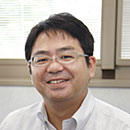
In the spring of 2011, CHIKYU conducts riser drilling in the sea area approx. 80km off the Shimokita Peninsula (IODP Expedition 337), aiming at 2,200meters below seafloor, deeper than 2,111m, the drilling depth record in ocean drilling science. A lot of results are expected by drilling through biosphere in gas-rich and coal layers, including new findings.
(Published in February 2011)
 |
Interviewee: Dr. Fumio Inagaki Geomicrobiology Group of the Kochi Institute for Core Sample Research |
Aiming at Renewing the Drilling Depth Record with Riser Drilling
In 2006, CHIKYU conducted drilling down to about 650meters below seafloor to the east of the Shimokita Peninsula (water depth: approx. 1,200m) during the shakedown cruise (Site C9001: Pilot Hole). In mid-March 2011, CHIKYU further drills deeper through the C9001 Hole by riser drilling, aiming at reaching 2,200meters, the depth unexplored in scientific ocean drilling. In this neighborhood, there is an immature coal (lignite) layers about 50million years ago (the Paleogene-Eocene in the Cenozoic Era), above which a natural gas area exists. As these strata have been difficult for riserless drilling, no scientific drilling has been conducted.
‘By drilling through the natural gas field and drilling down until the lignite coal layers deeply buried in the subseafloor, the whole picture of the energy cycle system of hydrocarbon, where the lignite coal layers are the mother rocks, should be revealed. In addition, we hope to elucidate the actual conditions of biological activities, that is, how many microbes exist there and what kinds of roles they perform’, Dr. Fumio Inagaki, Co-Chief Scientist, talks about the purpose of the research. ‘However, to that end, there is a major challenge’, says Dr. Inagaki. That is to collect core samples with good quality’. The depth around the unconformity (approx. 1,800meters) which forms the boundary between the marine sediments and terrigenous sediments below them is an important place for the research. But the strata are brittle in the place, which creates the problem of whether clean core samples with less contamination can be collected. It is expected that the lignite coal layers, where sandstone and lignite forms layer structure, are also brittle. Collecting high-quality core samples in such a place greatly influence the study at a laboratory with real subseafloor environment planned after the coring expedition.
- |1|
- 2|


